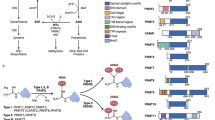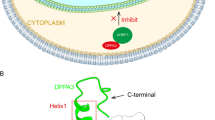Abstract
Serine/threonine kinase Akt (also called protein kinase B, PKB) is a downstream effector of phosphoinositide 3-kinase (PI3K) and functions as the focal point for many signal transduction pathways such as glucose metabolism, transcription, cell survival, angiogenesis, and cell motility. Akt is emerging as a central player in tumorigenesis including human ovarian, pancreatic, prostate, breast, and gastric cancers. However, the function and mechanism by which Akt regulate gene transcription in nucleus remains largely unclear. Here we identify histone methyltransferase SETDB1 as a novel nuclear interacting partner of Akt. By yeast two-hybrid screening, we obtained the Akt1-SETDB1 interaction and confirmed the binding both in vitro and in vivo. Both Akt1 and SETDB1 are co-localized in the nucleus in mammalian cells. SETDB1 is not a phosphorylation substrate of Akt kinase. Akt and SETDB1 could coordinate to regulate the activity of certain transcription factors such as forkhead family member. Due to the fact that SETDB1 acts as a specific histone H3, lysine 9-methyltransferase in vivo, we provide the first link between Akt kinase and histone methyltransferase (HMTase). This interaction represents a novel mechanism by which Akt regulates nuclear events including gene transcription.





Similar content being viewed by others
References
Datta SR, Brunet A, Greenberg ME (1999) Cellular survival: a play in three Akts. Genes Dev 13:2905–2927
Brazil DP, Hemmings BA (2001) Ten years of protein kinase B signalling: a hard Akt to follow. Trends Biochem Sci 26:657–664
Lawlor MA, Alessi DR (2001) PKB/Akt: a key mediator of cell proliferation, survival and insulin responses?. J Cell Sci 114:2903–2910
Testa JR, Bellacosa A (2001) AKT plays a central role in tumorigenesis. Proc Natl Acad Sci USA 98:10983–10985
Brazil DP, Park J, Hemmings BA (2002) PKB binding proteins: getting in on the Akt. Cell 111:293–303
Enomoto A, Murakami H, Asai N et al (2005) Akt/PKB regulates actin organization and cell motility via Girdin/APE. Dev Cell 9:389–402
Bellacosa A, Testa JR, Staal SP et al (1991) A retroviral oncogene, akt, encoding a serine-threonine kinase containing an SH2-like region. Science 254:274–277
Coffer PJ, Woodgett JR (1991) Molecular cloning and characterisation of a novel putative protein-serine kinase related to the cAMP-dependent and protein kinase C families. Eur J Biochem 201:475–481
Jones PF, Jakubowicz T, Pitossi FJ et al (1991) Molecular cloning and identification of a serine/threonine protein kinase of the second-messenger subfamily. Proc Natl Acad Sci USA 88:4171–4175
Franke TF, Kaplan DR, Cantley LC (1997) PI3K: downstream AKTion blocks apoptosis. Cell 88:435–437
Stephens L, Anderson K, Stokoe D et al (1998) Protein kinase B kinases that mediate phosphatidylinositol 3,4,5-trisphosphate-dependent activation of protein kinase B. Science 279:710–714
Andjelkovic M, Alessi DR, Meier R et al (1997) Role of translocation in the activation and function of protein kinase B. J Biol Chem 272:31515–31524
Hill MM, Feng J, Hemmings BA (2002) Identification of a plasma membrane raft-associated PKB Ser473 kinase activity that is distinct from ILK and PDK1. Curr Biol 12:1251–1255
Filippa N, Sable CL, Hemmings BA et al (2000) Effect of phosphoinositide-dependent kinase 1 on protein kinase B translocation and its subsequent activation. Mol Cell Biol 20:5712–5721
Datta SR, Dudek H, Tao X et al (1997) Akt phosphorylation of BAD couples survival signals to the cell-intrinsic death machinery. Cell 91:231–241
Cardone MH, Roy N, Stennicke HR et al (1998) Regulation of cell death protease caspase-9 by phosphorylation. Science 282:1318–1321
Brunet A, Bonni A, Zigmond MJ et al (1999) Akt promotes cell survival by phosphorylating and inhibiting a forkhead transcription factor. Cell 96:857–868
Staal SP, Hartley JW, Rowe WP (1997) Isolation of transforming murine leukemia viruses from mice with a high incidence of spontaneous lymphoma. Proc Natl Acad Sci USA 74:3065–3067
Sun M, Wang G, Paciga JE et al (2001) AKT1/PKBalpha kinase is frequently elevated in human cancers and its constitutive activation is required for oncogenic transformation in NIH3T3 cells. Am J Pathol 159:431–437
Bellacosa A, de Feo D, Godwin AK et al (1995) Molecular alterations of the AKT2 oncogene in ovarian and breast carcinomas. Int J Cancer 64:280–285
Cheng JQ, Ruggeri B, Klein WM et al (1996) Amplification of AKT2 in human pancreatic cells and inhibition of AKT2 expression and tumorigenicity by antisense RNA. Proc Natl Acad Sci USA 93:3636–3641
Yuan ZQ, Sun M, Feldman RI et al (2000) Frequent activation of AKT2 and induction of apoptosis by inhibition of phosphoinositide-3-OH kinase/Akt pathway in human ovarian cancer. Oncogene 19:2324–2330
Nakatani K, Thompson DA, Barthel A et al (1999) Up-regulation of Akt3 in estrogen receptor-deficient breast cancers and androgen-independent prostate cancer lines. J Biol Chem 274:21528–21532
Ogawara Y, Kishishita S, Obata T et al (2002) Akt enhances Mdm2-mediated ubiquitination and degradation of p53. J Biol Chem 277:21843–21850
Mayo LD, Donner DB (2001) A phosphatidylinositol 3-kinase/Akt pathway promotes translocation of Mdm2 from the cytoplasm to the nucleus. Proc Natl Acad Sci USA 98:11598–11603
Lund AH, van Lohuizen M (2004) Epigenetics and cancer. Genes Dev 18:2315–2335
Schultz DC, Ayyanathan K, Negorev D et al (2002) SETDB1: a novel KAP-1-associated histone H3, lysine 9-specific methyltransferase that contributes to HP1-mediated silencing of euchromatic genes by KRAB zinc-finger proteins. Genes Dev 16:919–932
Yang L, Xia L, Wu DY et al (2002) Molecular cloning of ESET, a novel histone H3-specific methyltransferase that interacts with ERG transcription factor. Oncogene 21:148–152
Qian C, Zhou MM (2006) SET domain protein lysine methyltransferases: structure, specificity and catalysis. Cell Mol Life Sci 63:2755–2763
Botuyan BM, Lee J, Ward IM et al (2006) Structural basis for the methylation state-specific recognition of histone H4-K20 by 53BP1 and Crb2 in DNA repair. Cell 127:1361–1373
Matsuzawa S, Reed JC (2001) Siah-1, SIP, and Ebi collaborate in a novel pathway for b-catenin degradation linked to p53 responses. Mol Cell 7:915–926
Aoki M, Batista O, Bellacosa A et al (1998) The Akt kinase: molecular determinants of oncogenicity. Proc Natl Acad Sci USA 95:14950–14955
Cho H, Mu J, Kim JK et al (2001) Insulin resistance and a diabetes mellitus-like syndrome in mice lacking the protein kinase Akt2 (PKB beta). Science 292:1728–1731
Scheid MP, Woodgett JR (2001) Pkb/akt: functional insights from genetic models. Nat Rev Mol Cell Biol 2:760–768
Cross DA, Alessi DR, Cohen P et al (1995) Inhibition of glycogen synthase kinase-3 by insulin mediated by protein kinase B. Nature 378:785–789
Zhou BP, Liao Y, Xia W et al (2001). HER-2/neu induces p53 ubiquitination via Akt-mediated MDM2 phosphorylation. Nat Cell Biol 3:973–982
Zhou BP, Liao Y, Xia W et al (2001) Cytoplasmic localization of p21Cip1/WAF1 by Akt-induced phosphorylation in HER-2/neu-overexpressing cells. Nat Cell Biol 3:245–252
Inoki K, Li Y, Zhu T et al (2002) TSC2 is phosphorylated and inhibited by Akt and suppresses mTOR signalling. Nat Cell Biol 4:648–657
Potter CJ, Pedraza LG, Xu T (2002) Akt regulates growth by directly phosphorylating Tsc2. Nat Cell Biol 4:658–665
Alessi DR, Caudwell FB, Andjelkovic M et al (1996) Molecular basis for the substrate specificity of protein kinase B; comparison with MAPKAP kinase-1 and p70 S6 kinase. FEBS Lett 399:333–338
Blackburn ML, Chansky HA, Zielinska-Kwiatkowska A et al (2003) Genomic structure and expression of the mouse ESET gene encoding an ERG-associated histone methyltransferase with a SET domain. Biochim Biophys Acta 1629:8–14
Laine J, Kunstle G, Obata T et al (2000) The protooncogene TCL1 is an Akt kinase coactivator. Mol Cell 6:395–407
Maira SM, Galetic I, Brazil DP et al (2001) Carboxyl-terminal modulator protein (CTMP), a negative regulator of PKB/Akt and v-Akt at the plasma membrane. Science 294:374–380
Sato S, Fujita N, Tsuruo T (2000) Modulation of Akt kinase activity by binding to Hsp90. Proc Natl Acad Sci USA 97:10832–10837
Jahn T, Seipel P, Urschel S et al (2002) Role for the adaptor protein Grb10 in the activation of Akt. Mol Cell Biol 22:979–991
Paramio JM, Segrelles C, Ruiz S et al (2001) Inhibition of protein kinase B (PKB) and PKCzeta mediates keratin K10-induced cell cycle arrest. Mol Cell Biol 21:7449–7459
Li H, Rauch T, Chen ZX et al (2006) The histone methyltransferase SETDB1 and the DNA methyltransferase DNMT3A interact directly and localize to promoters silenced in cancer cells. J Biol Chem 281:19489–19500
Rea S, Eisenhaber F, Carroll D et al (2000) Regulation of chromatin structure by site-specific histone H3 methyltransferase. Nature 406:593–599
Martin C, Zhang Y (2005) The diverse functions of histone lysine methylation. Nat Rev Mol Cell Biol 6:838–849
Acknowledgment
This work was supported by Chinese National Natural Science Foundation Projects (30600846).
Author information
Authors and Affiliations
Corresponding author
Additional information
Haidong Gao and Zhigang Yu contributed equally to this work.
Rights and permissions
About this article
Cite this article
Gao, H., Yu, Z., Bi, D. et al. Akt/PKB interacts with the histone H3 methyltransferase SETDB1 and coordinates to silence gene expression. Mol Cell Biochem 305, 35–44 (2007). https://doi.org/10.1007/s11010-007-9525-3
Received:
Accepted:
Published:
Issue Date:
DOI: https://doi.org/10.1007/s11010-007-9525-3




